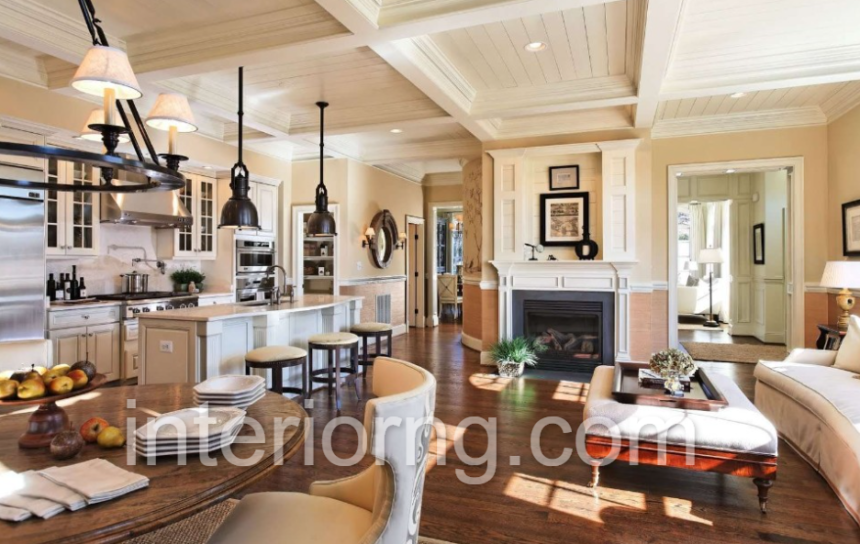American Interior Design-Interior design in the United States is a rich tapestry woven from diverse threads of culture, history, and innovation.
From the colonial era to the modern age, American interior design has evolved into a dynamic and ever-changing landscape.
In this comprehensive exploration, we will journey through the fascinating history, iconic styles, and influential designers that have shaped American interior design into the vibrant tableau it is today.

These Designs Include:
Colonial Elegance: The Birth of American Interior Design
The roots of American interior design can be traced back to the colonial period, where European influences merged with the practicality of a new land. Early American interiors were characterized by simplicity, functionality, and a reliance on locally sourced materials. The Colonial style, marked by warm wood tones, craftsmanship, and understated elegance, remains a timeless influence in American design.
The Victorian Era: Ornate Opulence
The 19th century ushered in the Victorian era, a time of opulent interiors characterized by intricate detailing, heavy furnishings, and a fascination with ornamentation. Victorian design was a reflection of the era’s fascination with exoticism and a desire to display wealth and prosperity. The ornate interiors featured intricate wallpaper patterns, elaborate moldings, and a profusion of decorative objects.
Arts and Crafts Movement: Embracing Simplicity
In response to the excesses of the Victorian era, the Arts and Crafts Movement emerged as a design philosophy that celebrated craftsmanship and simplicity. Pioneered by figures like Gustav Stickley and the Roycrofters, Arts and Crafts interiors favored natural materials, handcrafted furniture, and a focus on the inherent beauty of wood and other materials. This movement laid the foundation for modern American design principles.
Mid-Century Modern: The American Design Revolution
The mid-20th century witnessed a design revolution with the emergence of the Mid-Century Modern style. Influenced by the Bauhaus movement and Scandinavian design principles, Mid-Century Modern interiors embraced clean lines, organic forms, and a minimalist approach. Iconic designers like Charles and Ray Eames, Eero Saarinen, and Florence Knoll shaped the aesthetic of this era, creating furniture and interiors that remain highly sought after today.
Eclecticism and Fusion: A Modern Melting Pot
Contemporary American interior design is a fusion of diverse styles, reflecting the country’s multiculturalism and the influence of global design trends. Eclecticism reigns supreme, allowing designers to draw inspiration from various periods and cultures. This approach results in interiors that are uniquely American, yet globally informed.
Influential American Interior Designers
- Dorothy Draper: Known as the “First Lady of American Decorating,” Dorothy Draper pioneered the use of bold colors and patterns in interior design. Her work in iconic spaces like the Greenbrier Hotel in West Virginia continues to inspire designers today.
- Frank Lloyd Wright: Revered as one of the greatest American architects, Frank Lloyd Wright’s contributions extended to interior design. His concept of organic architecture seamlessly integrated interior spaces with their surroundings, creating a harmonious relationship between nature and design.
- Sister Parish: An influential figure in the world of American interior design, Sister Parish was celebrated for her ability to infuse warmth and personality into her interiors. Her collaboration with Albert Hadley gave birth to the timeless “Parish-Hadley” style.
- Elsie de Wolfe: Often considered the first professional interior decorator, Elsie de Wolfe introduced an innovative approach to interior design that emphasized comfort and functionality. Her work in the early 20th century laid the groundwork for modern interior design practices.
- Billy Baldwin: Renowned for his impeccable taste and ability to create inviting interiors, Billy Baldwin’s work is synonymous with American style. His designs favored comfort and practicality without sacrificing elegance.
Modern Trends in American Interior Design
Today, American interior design continues to evolve with changing tastes, technology, and sustainability concerns. Some of the prominent trends in contemporary American design include:
- Sustainable Design: The focus on eco-friendly materials and sustainable practices has gained prominence in American interior design. Designers are increasingly incorporating environmentally conscious elements into their projects.
- Open-Concept Living: The open-concept layout, which blurs the lines between living, dining, and kitchen areas, remains a popular trend, emphasizing communal living and a sense of spaciousness.
- Minimalism: Minimalist design principles, characterized by clean lines, neutral color palettes, and a “less is more” approach, continue to influence American interiors.
- Biophilic Design: With an increasing emphasis on well-being, biophilic design seeks to connect interior spaces with nature. Incorporating natural elements, such as indoor plants and natural light, is a growing trend.
- Mixing Old and New: Eclecticism remains a defining feature of American interior design, with designers skillfully blending antique and contemporary elements to create unique, personalized spaces.
FINAL THOUGHT
American interior design is a dynamic and ever-evolving journey through time, encompassing a diverse range of styles, influences, and innovations. From its colonial origins to the present day, American design has continuously adapted to reflect the changing needs and tastes of its inhabitants.
With a rich history of influential designers, iconic styles, and a commitment to innovation, American interior design continues to shape the way we live, work, and experience our surroundings. As the nation’s cultural tapestry grows richer and more diverse, so too does the world of interior design.




